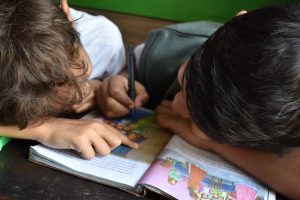By: Daniel Stockwell, Clemson University PhD Student
Who Are Emergent Bilinguals, and What is Culturally Sustaining Pedagogy?
I was once an emergent bilingual (EB) student. My family moved to Ukraine right before I entered first grade, and while I spoke English at home, the language of school was Ukrainian. My first experiences with public education were in a Ukrainian school roughly one month after arriving in the country. I did not speak the language, and I did not know much about the cultural norms of the classroom, but I needed to be engaged in authentic, meaningful learning. Instead, the teacher gave me toys and told me to sleep whenever I wanted to.
Emergent bilingual (EB) students in the United States are those who speak a language other than English at home and are learning English at school but are not considered proficient in English. These students are often referred to as English Language Learners (ELLs). García and Kleifgen (2010) argued that they should be referred to as emergent bilingual students to highlight their linguistic strengths, not what they lack, and I completely agree with them.

The languages a person speaks are essential components of their culture, so EB students bring with them unique linguistic strengths and cultures into the classroom. To engage these students, as we should engage all students, in rigorous academic instruction and participation, educators will need to implement culturally sustaining pedagogy (CSP) in their classrooms. The James A. and Cherry A. Banks Professor of Multicultural Education Django Paris (2012) explained that CSP is part of the “struggle toward an education that honors and extends the languages and literacies and practices of our students and communities in the project of social and cultural justice” (p. 96). CSP is no single list of practices or strategies. Rather, to implement CSP, teachers must learn about and value their students’ unique cultures and ways of knowing and doing. Teaching practices that implement CSP stem from this knowledge of individual EB students.
What Questions Can I Ask Myself as I Implement Culturally Sustaining Pedagogy with Emergent Bilingual Students?
Good teachers reflect on the instruction they provide, they look at formative and summative assessment data, and they ask themselves questions as they strive to improve and work to engage students in meaningful learning. This is a never-ending process because educators are life-long learners. No list of questions (or strategies) can cover everything educators could or should think about as they implement CSP with EB students. All students are different and unique. EB students come from diverse cultural backgrounds, nationalities, and families, who all have their own ways of using language to learn. So, educators will need to keep asking questions. The list that follows is meant to help educators begin thinking about how they can implement CSP with their specific EB students. It is a start that emphasizes the hard questions we all have to ask ourselves, over and over again.
How do I view my EB students?
Do you have deficit perspectives of EB students? Do you find yourself unconsciously associating their limited English proficiency with their intelligence? Do you think their culture is somehow inferior to your own?

If educators have deficit perspectives of their EB students, teachers will likely have lower expectations for their academic achievement, which has long-lasting consequences for these students.
Imagine trying to apply to college if you were tracked and placed in lower-level courses based on your perceived proficiency in a different language. Many EB students are schooled in contexts that do not give them access to advanced placement (AP) courses while they maintain the label of English Language Learners. In these settings, the language needs of EB students are placed above their academic needs. Unfortunately for these EB students, the most important predictor of student persistence in obtaining a baccalaureate degree is the academic rigor of their high school courses (Wassmer et al., 2004). EB students have a right to rigorous academic engagement. Do you think your EB students are ready for the kind of instruction they deserve?
Who does the accommodating in my classroom?
Do your EB students have to do all the accommodating necessary for learning and teaching to take place? Do they always have to change the ways they talk and think? How they interact with authority in the classroom? How they learn? How they view schooling and their role in their own education?
EB students and their parents want to be involved in their learning and in the culture of the classroom, but they should not have to change everything about themselves in order to participate fully. Also, parents who do not speak English want to help their children with homework assignments; are you making it possible for them to be involved?
Nieto and Bode (2018) advocate for teachers to participate in mutual accommodation. This means educators need to be willing to make some accommodations themselves to help EB students achieve academic success. Schools, parents, and students need to work together. Teachers need to make sure to accommodate their instructional practices so that they are culturally sustaining. Teachers need to affirm the languages, cultures, and ways of knowing and doing that their EB students bring into the classroom.
What counts as official knowledge in my classroom? Who counts as knowledgeable?
How do you view your role as the teacher? Is it up to you to fill the students minds with as much content as possible? Or do you see your classroom as a place for you and your students to build knowledge together? If so, what counts as knowledge? Whose knowledge is valued and whose is ignored?

Teachers can plan times for their EB students to teach the class so that they can be the experts for a while. Allowing EB students to share elements of their culture, creative ways of thinking about a problem, or ways of knowing and doing that are different from the dominant group’s shows the entire class that all students have knowledge that is official and valuable. This is culturally sustaining; it communicates to EB students that their cultures are not just acknowledged by schools but are welcomed and valued.
Is my classroom “English Only”?
Do you tell your EB students to speak or write only in English in your classroom? Are they allowed to read in the language they use at home, or only in English?
Martínez (2010) studied EB middle school students in East Los Angeles to explore how they used Spanglish daily in their English language arts and social studies classes. While some use the term Spanglish in the pejorative sense, I do not. Martínez, other researchers, and I use this term to refer to the skillful and creative use of features of both Spanish and English to communicate. Martínez demonstrated that the EB middle school students used Spanglish in ways that met the California state standards for listening, speaking, and reading. Teachers should consider allowing other languages to be used in class to give students access to rigorous academic engagement and to give them practice with using language to communicate in meaningful ways.

Teachers can allow their students to engage in translanguaging. Researchers and educators have a few different conceptions of what translanguaging is; one understanding is that translanguaging is “the deployment of a speaker’s full linguistic repertoire without regard for watchful adherence to the socially and politically defined boundaries of named (and usually national and state) languages” (Otheguy et al., 2015, p. 283). When EB students can use their complete linguistic repertoires, they feel valued and that their knowledge matters. Also, this allows them to engage in higher-order thinking because they can analyze, evaluate, and create more easily when they are not restricted to one language. Furthermore, when it comes to writing, teachers should consider the purpose of writing. Who are EB students writing for? Why are they writing? Teachers know that the process of writing, not the product, is when most learning takes place (Velasco & García, 2014). Allowing EB students to translanguage as they work on their writing assignments engages them in rigorous instruction; even if their English writing skills are not at grade level, their thinking can be. Translanguaging opens up doors of opportunity for their advancement as writers.
What are my goals for EB students? Do you have high expectations for them? Does your school measure their success with EB students based on how many are reclassified out of the English Language Learners program? Is your highest goal for them to be able to graduate from high school one day?
A Final Question

This last question is about asking yourself, “What are the goals of my EB students for themselves?” If we do not know the personal goals of our EB students and their families, we probably are not teaching in ways that are culturally sustaining.
If EB students’ linguistic skills and cultures are valued and incorporated into the official curriculum in schools, EB students will be able to pursue their own goals, and we will be better positioned to help them.
References
García, O., & Kleifgen, J. A. (2010). Educating emergent bilingual students: Policies, programs, and practices for English language learners. Teachers College Press.
Martínez, R. A. (2010). “Spanglish” as literacy tool: Toward an understanding of the potential role of Spanish-English code-switching in the development of academic literacy. Research in the Teaching of English, 45(2), 124–149.
Nieto, S., & Bode, P. (2018). Affirming diversity: The sociopolitical context of multicultural education (7th ed.). Pearson.
Otheguy, R., García, O., & Reid, W. (2015). Clarifying translanguaging and deconstructing named languages: A perspective from linguistics. Applied Linguistics Review 6(3), 281–307.
Paris, D. (2012). Culturally sustaining pedagogy: A needed change in stance, terminology, and practice. Educational Researcher, 41(3), 93–97.
Velasco, P., & García, O. (2014). Translanguaging and the writing of bilingual learners. Bilingual Research Journal, 37(1), 6–23.
Wassmer, R., Moore, C., & Shulock, N. (2004). Effect of racial/ethnic composition on transfer rates in community colleges: Implications for policy and practice. Research in Higher Education, 45(6), 651–672.
About the Author

Daniel is a Ph.D. student in the Literacy, Language, and Culture program at Clemson University. Before entering this program, he was a high school English teacher in Greenville, South Carolina.

2 replies on “Culturally Sustaining Pedagogy for Emergent Bilingual Students”
I have the same perspective as yours that “All students are different and unique”. All students should have the right to accept equal education so that their potential talents can be recognized and developed. Teachers should acknowledge English learners’ language and culture as their strength in academic learning and the world economy. Educators should provide English learners with more opportunities to explore and engage their learning.
How can teachers go about the process of understanding how “students are different and unique”?